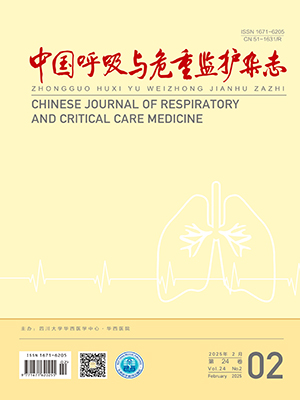| 1. |
Karthika M, Al Enezi FA, Pillai LV, et al. Rapid shallow breathing index. Ann Thorac Med, 2016, 1(3): 167-176.
|
| 2. |
Hudson MB, Smuder AJ, Nelson WB, et al. Both high level pressure support ventilation and controlled mechanical ventilation induce diaphragm dysfunction and atrophy. Crit Care Med, 2012, 40: 1254-1260.
|
| 3. |
Chen LY, Gilstrap D, Cox CE. Mechanical ventilator discontinuation process. Clin Chest Med, 2016, 37(4): 693-699.
|
| 4. |
Esteban A, Anzueto A, Frutos F, et al. Characteristics and outcomes in adult patients receiving mechanical ventilation: a 28-day international study. JAMA, 2002, 287(3): 345-355.
|
| 5. |
Ely EW, Baker AM, Evans GW, et al. The prognostic significance of passing a daily screen of weaning parameters. Intensive Care Med, 1999, 25(6): 581-587.
|
| 6. |
Heunks LM, van der Hoeven JG. Clinical review: the ABC of weaning failure-a structured approach. Crit Care, 2010, 14(6): 245.
|
| 7. |
Spadaro S, Grasso S, Mauri T, et al. Can diaphragmatic ultrasonography performed during the T-tube trial predict weaning failure? The role of diaphragmatic rapid shallow breathing index. Crit Care, 2016, 20(1): 305.
|
| 8. |
Eltrabili HH, Hasanin AM, Soliman MS, et al. Evaluation of diaphragmatic ultrasound indices as predictors of successful liberation from mechanical ventilation in subjects with abdominal sepsis. Respir Care, 2019, 64(5): 564-569.
|
| 9. |
Perkins GD, Mistry D, Gates S, et al. Effect of protocolized weaning with early extubation to noninvasive ventilation vs invasive weaning on time to liberation from mechanical ventilation among patients with respiratory failure: the breathe randomized clinical trial. JAMA, 2018, 320(18): 1881-1888.
|
| 10. |
Umbrello M, Formenti P, Longhi D, et al. Diaphragm ultrasound as indicator of respiratory effort in critically ill patients undergoing assisted mechanical ventilation: a pilot clinical study. Crit Care, 2015, 19: 161.
|
| 11. |
Xiao K, Su LX, Han BC, et al. Prognosis and weaning of elderly multiple organ dysfunction syndrome patients with invasive mechanical ventilation. Chin Med J (Engl), 2014, 127(1): 11-17.
|
| 12. |
Macintyre NR. Evidence-based assessments in the ventilator discontinuation process. Respir Care, 2012, 57(10): 1611-1618.
|
| 13. |
MacIntyre NR, Cook DJ, Ely EW Jr, et al. Evidence-based guidelines for weaning and discontinuing ventilatory support: a collective task force facilitated by the American College of Chest Physicians; the American Association for Respiratory Care; and the American College of Critical Care Medicine. Chest, 2001, 120(6 Suppl): 375-395.
|
| 14. |
Girard TD, Alhazzani W, Kress JP, et al. An Official American Thoracic Society/American College of Chest Physicians Clinical Practice Guideline: Liberation from Mechanical Ventilation in Critically Ill Adults. Rehabilitation Protocols, Ventilator Liberation Protocols, and Cuff Leak Tests. Am J Respir Crit Care Med, 2017, 195(1): 120-133.
|
| 15. |
Davidson AC, Banham S, Elliott M, et al; BTS Standards of Care Committee Member, British Thoracic Society/Intensive Care Society Acute Hypercapnic Respiratory Failure Guideline Development Group, On behalf of the British Thoracic Society Standards of Care Committee. BTS/ICS guideline for the ventilatory management of acute hypercapnic respiratory failure in adults. Thorax, 2016, 71 Suppl 2: ii1-ii35. Erratum in: Thorax, 2017, 72(6): 588.
|
| 16. |
Ouellette DR, Patel S, Girard TD, et al. Liberation From Mechanical Ventilation in Critically Ill Adults: An Official American College of Chest Physicians/American Thoracic Society Clinical Practice Guideline: Inspiratory Pressure Augmentation During Spontaneous Breathing Trials, Protocols Minimizing Sedation, and Noninvasive Ventilation Immediately After Extubation. Chest, 2017, 151(1): 166-180.
|
| 17. |
Baptistella AR, Sarmento FJ, da Silva KR, et al. Predictive factors of weaning from mechanical ventilation and extubation outcome: a systematic review. J Crit Care, 2018, 48: 56-62.
|
| 18. |
Yang KL, Tobin MJ. A prospective study of indexes predicting the outcome of trials of weaning from mechanical ventilation. N Engl J Med, 1991, 324(21): 1445-1450.
|
| 19. |
Tanios MA, Nevins ML, Hendra KP, et al. A randomized, controlled trial of the role of weaning predictors in clinical decision making. Crit Care Med, 2006, 34(10): 2530-2535.
|
| 20. |
Jung B, Nougaret S, Conseil M, et al. Sepsis is associated with a preferential diaphragmatic atrophy: a critically ill patient study using tridimensional computed tomography. Anesthesiology, 2014, 120(5): 1182-1191.
|
| 21. |
Jaber S, Jung B, Matecki S, et al. Clinical review: ventilator-induced diaphragmatic dysfunction-human studies confirm animal model findings!. Crit Care, 2011, 15(2): 206.
|
| 22. |
Danaga AR, Gut AL, Antunes LC, et al. Evaluation of the diagnostic performance and cut-off value for the rapid shallow breathing index in predicting extubation failure. J Bras Pneumol, 2009, 35(6): 541-547.
|
| 23. |
dos Reis HF, Almeida ML, da Silva MF, et al. Association between the rapid shallow breathing index and extubation success in patients with traumatic brain injury. Rev Bras Ter Intensiva, 2013, 25(3): 212-217.
|
| 24. |
El Khatib MF, Jamaleddine GW, Khoury AR, et al. Effect of continuous positive airway pressure on the rapid shallow breathing index in patients following cardiac surgery. Chest, 2002, 121(2): 475-479.
|
| 25. |
Patel KN, Ganatra KD, Bates JH, et al. Variation in the rapid shallow breathing index associated with common measurement techniques and conditions. Respir Care, 2009, 54(11): 1462-1466.
|
| 26. |
Zhang B, Qin YZ. Comparison of pressure support ventilation and T piece in determining rapid shallow breathing index in spontaneous breathing trials. Am J Med Sci, 2014, 348(4): 300-305.
|
| 27. |
窦志敏, 李红, 朱磊, 等. 膈肌浅快呼吸指数对机械通气慢性阻塞性肺疾病患者撤机的预测价值. 中国呼吸与危重监护杂志, 2018, 17(2): 124-127.
|




